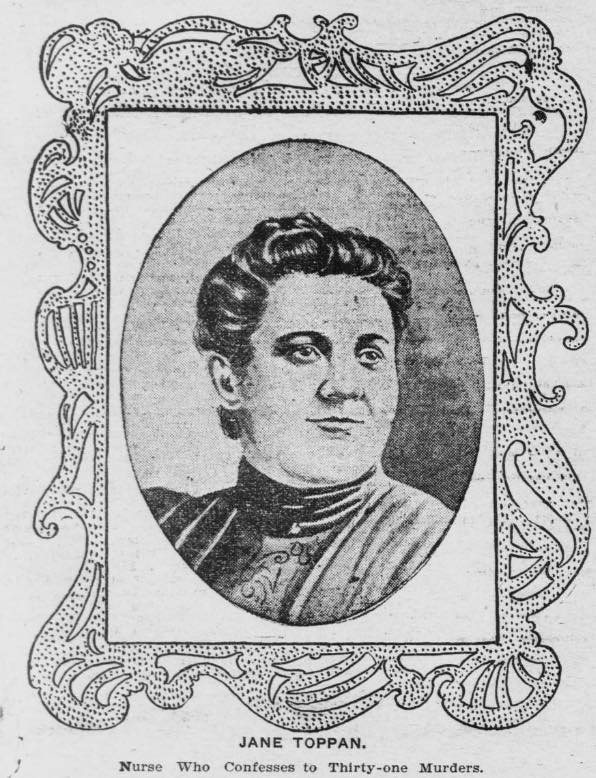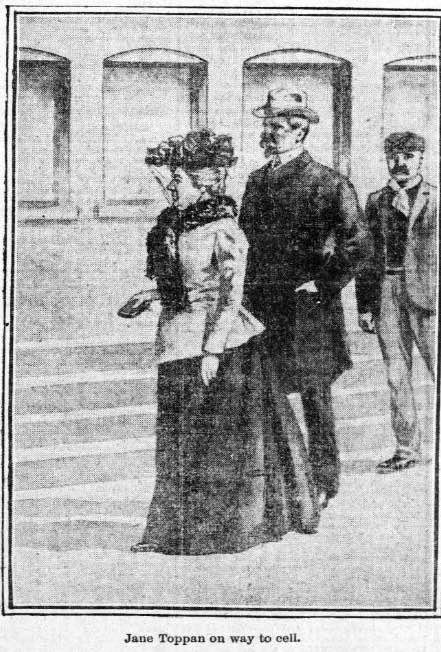
Jane Toppan was a round woman who put on a happy smile as she cared for her patients. Little did anyone know, she was actually an Angel of Death who believed in her diabolical mission to kill as many people as possible. Had she not made the fatal mistake of wiping out an entire family, she might never have been caught.

Her Childhood
It is easy to believe that Jane Toppan, originally named Honora “Nora” Kelly, was doomed from the start. Born in 1854 or 1857, she was the youngest of four sisters. Her mother had passed away while she was a year old. Sometime afterwards, her father went insane. He was a tailor and it was said that he was found in his shop attempting to sew his eyelids shut. He was sent to an asylum.
Jane and her three sisters were then shipped off to live with their father’s mother. The grandmother had no money to care for the four girls and Jane and her sisters were sent to an orphanage.
Jane was adopted by Abner and Ann Toppan when she was roughly 5 years old. Separated from the last of her family, she was given the new name of Jane Toppan, a name she kept for the rest of her life.
While in the care of her new parents, Jane excelled in school, but things were not well between her and her new mother. Ann was a very strict woman and she treated Jane like a servant, something that often happened to adopted girls at that time. [SOURCE 1]
Student Nurse
Unlike other women of her time, Jane never married. She felt she was destined for something greater. In 1887 she decided to become a nurse. She began school at the Cambridge Hospital nursing school in her hometown, Boston, Massachusetts.
Nursing was nothing like what it is today. While they had to train for 2 years, the same as today, their training was hands on. The young women lived together, worked seven days a week, twelve to fourteen hours a day, and each nurse would care for about 50 patients on a shift. They earned a mere $7 a week.
It was grueling work that included cooking meals and scrubbing floors, but Jane seemed to thrive in the environment. She often appeared cheerful and was said to have an excellent bedside manner. She was given the nickname Jolly Jane. [SOURCE 2]
Her Knowledge Of Drugs
Just as nurses today have to have a large knowledge of prescription drugs, nurses back in the 1880s also had to have an extensive knowledge of the medications used at that time.
To get her nursing diploma after her two years of training, Jane was tested on her knowledge of certain medications, such as morphine and atropine. She had to know the correct dosages of morphine for children and what to do if a patient received an overdose of the drug.
After taking her exam, she went on to become a nurse at the Massachusetts General Hospital. [SOURCE 4]

Her Initial Experiments
It is uncertain exactly when she began experimenting on patients, but it is generally believed that she began testing out the effects of morphine on patients while she was still in training to be a nurse.
She learned how to keep her favorite patients bedridden and totally dependent upon her by using morphine. Patients she did like would get an ugly surprise when she tested out morphine doses on them and then its opposite, atropine. While the morphine would slow a patient’s heart rate, the atropine would increase it and could cause severe convulsions.
By the time she began her nursing career in Massachusetts General Hospital, she was so efficient in the use of these two drugs that she began offing some of her patients.
Eventually, rumors started to come to light that Jane had given certain patients the wrong dosages of their medication and that she had falsified records.
To avoid any serious trouble, Jane left the hospital and eventually went into private nursing. [SOURCE 4]
How She Tricked Doctors
Jane became a master in the use of morphine and atropine. She would dose some patients with morphine and, before the patient fell into a coma, she would dissolve a tablet of atropine in water and force the patient to drink it. If her patient would lapse into a coma, Jane would give the patient the atropine by enema.
From near coma to convulsions, her patients would exhibit a wide range of symptoms that kept the doctors guessing as to what the problem was. Patients were diagnosed with everything, from heart disease to diabetes.
At times she would take her patients to the brink of death with her drug concoctions and then worked furiously to save them. She was proud and liked to show off her nursing skills in this manner, making herself out to be an extraordinary nurse. [SOURCE 3]
A Popular Private Nurse
It did not take long for Jane to become a distinguished private nurse and her weekly salary climbed from $7 to a whopping $25. She received excellent recommendations from physicians and testimonials from her patients. Wealthy patients wanted the services from the jovial, plump woman who appeared to care deeply about her previous patients.
There were only a few troubling reports regarding her care. Some patients reported that she would steal money or items from their homes. She would also borrow money from her patients and not repay it. Some patients claimed that she liked to tell little white lies, something that she had done since she was a child.
In spite of the negatives, people were willing to overlook them just to have her provide them with in home care. [SOURCE 2]
In Bed With The Dying
After Jane’s arrest, psychiatrists were disturbed to learn that murder was a sexual impulse for Jane. There were numerous accounts and admissions that she would get into bed with the person she had just poisoned and hold onto them until their spasms ceased.
According to Jane, she felt calm and clear headed when she would give a victim a fatal dose. It was almost like a sexual release and after it was over, she would go to sleep. Sometimes she would fall asleep in the bed with her dead victim. One time she got into bed with her victim’s child and had a good nap.
Jane was aware that what she was doing was wrong, but she had no remorse for her actions. [SOURCE 5]
Her Undoing
It was the summer of 1901 and Jane had just finished murdering her foster sister. She and her foster sister had been staying together at a vacation cottage that belonged to Alden Davis when Jane overdosed her sister into a coma and then death.
Alden Davis was a prominent man in his community. A real estate owner and hotel owner, he would arrange events to draw in tourists to his hotel. He was a married man with two daughters.
Alden’s wife, Mattie, had been having health problems for a few years and Jane quickly offered her services to the Davis family. With her impeccable references, the family accepted and Jane moved into their home.
Instead of getting better, Mattie only grew worse. She eventually passed away and the doctor listed chronic diabetes as the cause of death.
Jane stayed to comfort the Davis family in their time of grief and in less than a week, one of the daughters took ill and mysteriously died.
Alden was next. His death was listed as the result of heart disease. Three days after his death, the final daughter died.
Jane had wiped out an entire family within six weeks and then left.
If it wasn’t for a vocal father-in-law, the deaths would have never been investigated and Jane would have never come under suspicion. [SOURCE 3]

Killed Many
Jane was unbelievably calm when she was finally arrested for murder. Bodies had been exhumed and tested for poisons. Arsenic was detected in six of her victims.
At first she claimed that she was innocent, but after speaking to some of the best psychiatrists, she finally admitted to killing off a number of her patients.
She was tried and found guilty for the deaths of 31 people. Later on, she is reported to have said, “It would be safe to say that I killed at least 100 persons.” Her reason for killing so many of her patients was that she did it for the fun of it. She also supposedly said that she wanted “to have killed more people – helpless people – than any other man or woman who ever lived…” [SOURCES 7, 1]
Into The Asylum
After 15 years of killing patients, Jane Toppan was found not guilty by reason of insanity. She was sentenced to spend the rest of her life at the Taunton State Hospital in Massachusetts.
While in the hospital, it was reported that she would often taunt the other nurses by saying, “Get the morphine, dearie, and we’ll go out into the ward. You and I will have a lot of fun seeing them die.” There was no way to repair Jane’s damaged mind. She lacked total empathy for the people she had murdered.
Unlike her victims, Jane lived to the ripe old age of 81 or 84, having died in 1938. [SOURCES 8, 6, 4]

